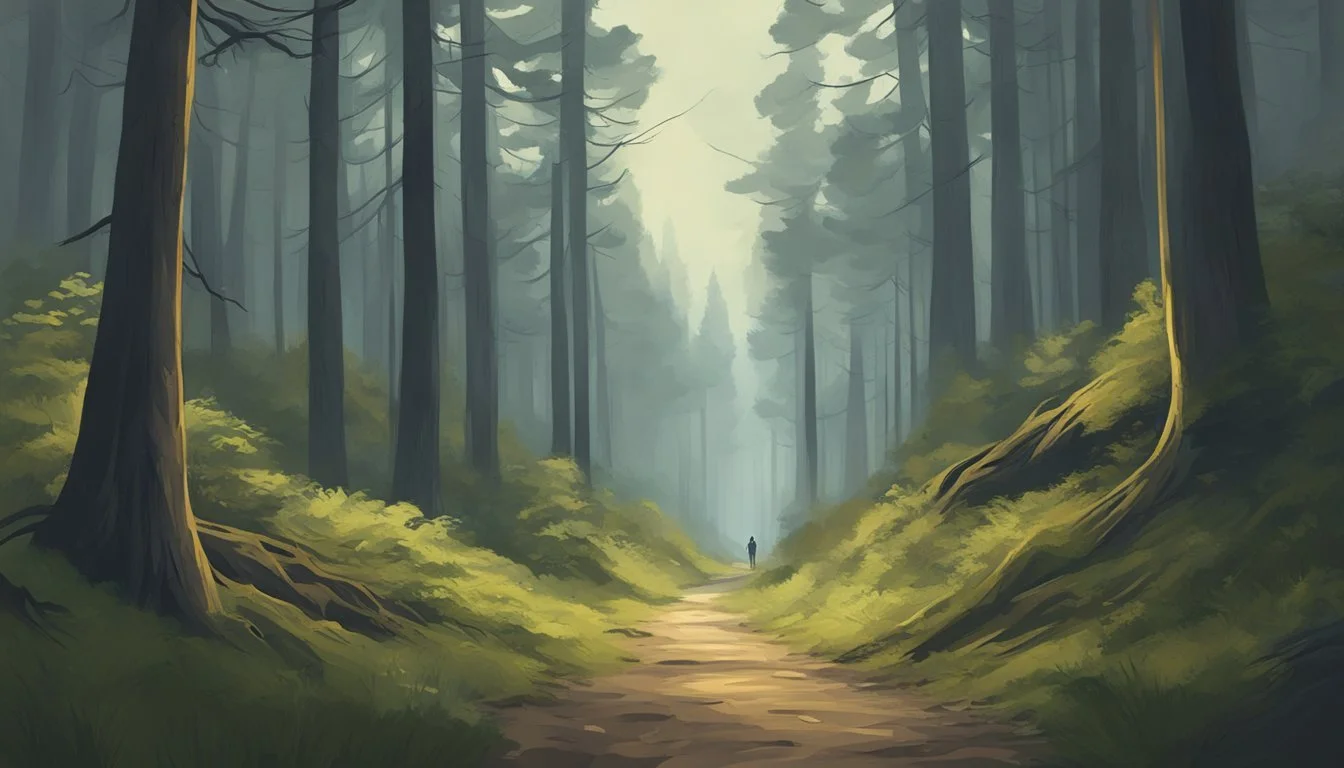David Carpenter's Final Trail: Trailside Killer Dies in Prison at 93
David Joseph Carpenter, notorious as the "Trailside Killer," died of natural causes on September 23, 2024, at the age of 94. His passing marks the end of a dark chapter in California's criminal history. Carpenter was responsible for at least seven murders and numerous attacks on hikers in the San Francisco Bay Area between 1979 and 1981.
Carpenter's reign of terror transformed the once-peaceful hiking trails of Mount Tamalpais and Santa Cruz Mountains into scenes of fear and violence. His victims, primarily young women, were stalked and brutally attacked in isolated areas. The murders sent shockwaves through local communities and forever changed the perception of safety in outdoor recreation.
Convicted in the 1980s, Carpenter spent over four decades on death row at San Quentin State Prison. His case garnered significant attention due to the nature of his crimes and their impact on public consciousness. While his death brings closure to some, it also resurfaces painful memories for the victims' families and survivors of his attacks.
Early Life of David Carpenter
David Joseph Carpenter's upbringing in San Francisco set the stage for his future criminal behavior. His troubled childhood and early offenses foreshadowed the violent acts he would later commit.
Background and Early Signs of Criminal Behavior
David Joseph Carpenter was born on May 6, 1930, in San Francisco, California. He endured physical abuse from his alcoholic father and overprotective mother during his formative years. This turbulent home life contributed to Carpenter's social difficulties and behavioral issues.
As a child, Carpenter struggled with a severe stutter, which made him a target for bullying. He developed a fascination with weapons at a young age, particularly knives.
Carpenter's criminal tendencies emerged early. At 17, he was arrested for molesting two of his cousins. This incident marked the beginning of his pattern of sexual offenses.
In his late teens and early twenties, Carpenter committed several assaults on women. These crimes resulted in multiple incarcerations, but failed to deter his violent behavior.
The Trailside Killings
David Carpenter terrorized Northern California hiking trails from 1979 to 1981, murdering at least eight people. His brutal crimes earned him the moniker "Trailside Killer" and left a lasting impact on the region's outdoor community.
Beginnings of a Serial Killer
Carpenter's criminal history began long before his killing spree. He served time for sexual assaults in the 1960s and 1970s. Upon release, he targeted hikers in secluded areas.
His first known murder occurred in August 1979. Carpenter shot and killed Edda Kane on Mount Tamalpais. This marked the start of his two-year reign of terror.
Carpenter's violent tendencies escalated quickly. He chose victims of opportunity, striking fear into the hearts of nature enthusiasts throughout the Bay Area.
Victims of the Trailside Killer
Carpenter claimed at least eight lives during his murderous rampage. His victims included:
Edda Kane, 44
Barbara Schwartz, 23
Anne Alderson, 26
Diane O'Connell, 22
Shauna May, 25
Richard Stowers, 19
Cynthia Moreland, 18
Heather Scaggs, 20
Most victims were young women, though Carpenter also killed men. He targeted hikers, joggers, and couples in isolated areas.
Carpenter's crimes spanned multiple counties, including Marin, Santa Cruz, and San Francisco. The widespread nature of his attacks made him difficult to catch.
Modus Operandi of the Attacks
Carpenter's method was consistent. He ambushed victims on secluded trails, often in broad daylight. He used a .38 caliber revolver in most attacks.
The killer typically approached victims under the guise of asking for directions. He then forced them off-trail at gunpoint.
Carpenter raped female victims before murdering them. He shot all his victims, usually at close range. Some bodies were found partially undressed or posed.
His attacks grew bolder over time. Carpenter sometimes targeted couples, killing male companions first. He left few clues, making the case challenging for investigators.
David Carpenter's Arrest and Trial
David Carpenter's capture marked the end of his reign of terror on California hiking trails. His trials captivated the public and showcased the legal system's efforts to bring justice for his victims.
Capture and Incrimination
In May 1981, law enforcement apprehended David Carpenter after a series of brutal attacks on hiking trails. A composite sketch and eyewitness accounts led to his arrest. Investigators found crucial evidence linking him to multiple murders.
DNA evidence and ballistics tests connected Carpenter to crime scenes. Survivors' testimonies proved instrumental in building the case against him. Police discovered a .38 caliber revolver in his possession, matching the weapon used in several killings.
Notorious Trials and Public Reaction
Carpenter faced trials in multiple counties for his crimes. In 1984, he was convicted of two murders in Santa Cruz County. The trial garnered significant media attention, with the public closely following the proceedings.
In 1988, another trial in Marin County resulted in convictions for five additional murders. Prosecutors presented compelling evidence, including forensic analysis and witness statements. The trials exposed the full extent of Carpenter's criminal activities.
Public reaction to the trials was intense. Many expressed relief at Carpenter's capture and conviction. The cases highlighted the importance of DNA evidence and cooperation between law enforcement agencies in solving complex crimes.
The Legal Process
David Carpenter faced a complex legal journey after his arrest for the Trailside Killings. His case involved multiple trials, convictions, and appeals spanning several decades.
Death Row and Appeals
Carpenter received two separate death sentences for his crimes. The first came in 1984 for murders in Marin County, followed by another in 1988 for killings in Santa Cruz County. After each conviction, he was placed on California's death row at San Quentin State Prison. Carpenter's legal team filed numerous appeals over the years. The California Supreme Court reviewed and upheld both death sentences in 1997 and 1999. Further appeals moved through the federal court system but were ultimately unsuccessful in overturning the convictions or sentences.
Special Circumstances and Death Sentence
Prosecutors pursued the death penalty based on special circumstances in Carpenter's cases. These included multiple murders and killings committed during rape or attempted rape. The juries in both trials found these special circumstances to be true. This allowed them to recommend death sentences. The judges in each case agreed and formally imposed capital punishment. California law required automatic appeals for death sentences. This process contributed to Carpenter spending over three decades on death row while his cases were reviewed by higher courts.
Impact on Hiking Communities
David Carpenter's crimes as the Trailside Killer profoundly affected hiking culture and safety measures in California's parks. His attacks on popular trails led to significant changes in how people approached outdoor recreation and how park authorities managed visitor security.
Shifting Hiking Culture in California
Carpenter's murders sparked fear among hikers, particularly in the San Francisco Bay Area. Many avoided solo hikes, opting for group outings instead. Wilderness areas like Mount Tamalpais and the Santa Cruz Mountains saw a decline in visitor numbers. Hikers became more vigilant, carrying personal safety devices and informing others of their plans. Some trails in Point Reyes National Seashore and Henry Cowell Redwoods State Park saw reduced foot traffic.
Local hiking clubs organized safety workshops and buddy systems. The culture shifted towards a community-based approach to trail safety. Hikers shared real-time updates about trail conditions and suspicious activities through newly formed networks.
Security Measures in State Parks
California state parks implemented new security protocols in response to the Trailside Killer's attacks. Rangers increased patrols on popular trails, especially in Big Basin Redwoods State Park and other affected areas. Park authorities installed emergency call boxes at trailheads and key points along routes.
Many parks introduced mandatory check-in systems for solo hikers. Trail cameras were strategically placed to monitor remote areas. Park staff received additional training in visitor safety and emergency response. Some parks restricted access to certain trails during low-traffic periods.
These measures aimed to restore public confidence in the safety of California's hiking trails. While some criticized the increased surveillance, many hikers welcomed the enhanced security presence in wilderness areas.
Locations of Crimes
David Carpenter's murders spanned multiple counties and parks across Northern California. His victims were found in remote wilderness areas popular with hikers and nature enthusiasts.
Northern California's Landscape of Terror
Carpenter primarily targeted victims in Marin County and Santa Cruz County. In Marin, he struck at Point Reyes National Seashore Park, a sprawling coastal wilderness area. Several bodies were discovered on isolated hiking trails within the park.
The Mount Tamalpais area in Marin County was another focal point of Carpenter's crimes. Its network of scenic trails became hunting grounds for the Trailside Killer.
In Santa Cruz County, Carpenter claimed victims in Castle Rock State Park. This rugged, forested area along the Santa Cruz Mountains provided ample cover for his attacks.
Significant Areas Linked to the Trailside Murders
The San Francisco Bay Area formed the core of Carpenter's killing zone. His crimes stretched from Marin County in the north to Santa Cruz County in the south.
Key locations included:
Mount Tamalpais State Park
Point Reyes National Seashore
Castle Rock State Park
Santa Cruz Mountains
Carpenter exploited the region's abundance of hiking trails and secluded natural areas. He often targeted women walking or jogging alone on remote paths.
The geographical spread of his crimes across multiple jurisdictions initially hampered investigators' efforts to connect the murders.
Victim Remembrance
The victims of David Carpenter's heinous crimes left behind grieving families and communities. Their memories live on through various tributes and ongoing efforts for justice.
Tributes and Memorials
A memorial plaque at Mount Tamalpais State Park honors Carpenter's victims. It bears the names of those who lost their lives on the trails. Local hiking groups organize annual remembrance walks, retracing the paths where the crimes occurred. These events aim to reclaim the trails as safe spaces.
Some families have established scholarships in their loved ones' names. These funds support students pursuing careers in criminal justice or victim advocacy. The scholarships ensure the victims' legacies continue to make positive impacts.
Families' Struggle for Closure and Justice
Victims' families endured decades of legal proceedings. Many attended Carpenter's trials, providing emotional testimony about their loss. The long wait for justice took a toll, with some family members passing away before seeing the case fully resolved.
Support groups formed, connecting families who shared similar experiences. These networks provided emotional support and resources for navigating the complex legal system. Some relatives became vocal advocates for victims' rights, pushing for policy changes to improve how the justice system handles violent crime cases.
Despite Carpenter's death, some families continue to seek answers about unsolved cases potentially linked to him. They remain committed to uncovering the full truth about their loved ones' fates.
Cultural Impact and Media Portrayal
David Carpenter's crimes as the Trailside Killer left an indelible mark on public consciousness and popular media. His case became a focal point for true crime enthusiasts and sparked numerous productions exploring his heinous acts.
True Crime Narratives and Documentaries
The Trailside Killer case has been featured in several true crime documentaries and series. "Very Scary People" dedicated an episode to Carpenter, detailing his crimes and their impact on the San Francisco Bay Area. Other productions have explored his background, modus operandi, and the lasting effects of his actions on hiking culture and trail safety.
These documentaries often highlight the chilling nature of Carpenter's attacks, which occurred in seemingly idyllic natural settings. They serve to educate viewers about the case while also cautioning about potential dangers in outdoor recreational areas.
Public Perception and Influence on Popular Media
Carpenter's crimes significantly influenced public perception of safety in natural spaces. His actions led to increased awareness of personal security while hiking or jogging on trails. This shift in mindset has been reflected in various forms of media, including books, movies, and television shows that incorporate themes of danger in wilderness settings.
The Trailside Killer case has also been referenced in fictional crime dramas, often serving as inspiration for storylines involving serial killers who target victims in outdoor locations. This recurring theme in popular media continues to shape public consciousness about safety in natural environments.
David Carpenter's Death and Finality
David Carpenter, the infamous Trailside Killer, died in prison after decades on death row. His passing marked the end of a dark chapter in California's criminal history and brought closure to the victims' families.
End of an Era: Carpenter's Death
David Carpenter died on September 25, 2024, at San Quentin State Prison. He was 94 years old. The California Department of Corrections and Rehabilitation reported that Carpenter succumbed to natural causes.
Carpenter had been on death row since his conviction in 1984. He spent 40 years awaiting execution for his crimes.
Despite multiple appeals, Carpenter's death sentence remained in place. His advanced age and deteriorating health ultimately led to his passing before the state could carry out his execution.
The Closure of the Trailside Killer Case
Carpenter's death brought finality to the Trailside Killer case. It ended decades of legal proceedings and appeals.
Victims' families expressed mixed emotions upon hearing the news. Some felt relief, while others wished Carpenter had faced execution.
Law enforcement officials who worked on the case reflected on its impact. They noted how Carpenter's crimes changed public perception of safety in outdoor spaces.
The case remains a significant part of California's criminal history. It continues to influence trail safety measures and public awareness in the Bay Area.










